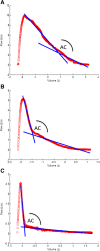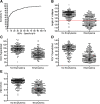Computer quantification of airway collapse on forced expiration to predict the presence of emphysema
- PMID: 24251975
- PMCID: PMC3870969
- DOI: 10.1186/1465-9921-14-131
Computer quantification of airway collapse on forced expiration to predict the presence of emphysema
Abstract
Background: Spirometric parameters are the mainstay for diagnosis of COPD, but cannot distinguish airway obstruction from emphysema. We aimed to develop a computer model that quantifies airway collapse on forced expiratory flow-volume loops. We then explored and validated the relationship of airway collapse with computed tomography (CT) diagnosed emphysema in two large independent cohorts.
Methods: A computer model was developed in 513 Caucasian individuals with ≥15 pack-years who performed spirometry, diffusion capacity and CT scans to quantify emphysema presence. The model computed the two best fitting regression lines on the expiratory phase of the flow-volume loop and calculated the angle between them. The collapse was expressed as an Angle of collapse (AC) which was then correlated with the presence of emphysema. Findings were validated in an independent group of 340 individuals.
Results: AC in emphysema subjects (N = 251) was significantly lower (131° ± 14°) compared to AC in subjects without emphysema (N = 223), (152° ± 10°) (p < 0.0001). Multivariate regression analysis revealed AC as best indicator of visually scored emphysema (R2 = 0.505, p < 0.0001) with little significant contribution of KCO, %predicted and FEV1, %predicted to the total model (total R2 = 0.626, p < 0.0001). Similar associations were obtained when using CT-automated density scores for emphysema assessment. Receiver operating characteristic (ROC) curves pointed to 131° as the best cut-off for emphysema (95.5% positive predictive value, 97% specificity and 51% sensitivity). Validation in a second group confirmed the significant difference in mean AC between emphysema and non-emphysema subjects. When applying the 131° cut-off, a positive predictive value of 95.6%, a specificity of 96% and a sensitivity of 59% were demonstrated.
Conclusions: Airway collapse on forced expiration quantified by a computer model correlates with emphysema. An AC below 131° can be considered as a specific cut-off for predicting the presence of emphysema in heavy smokers.
Figures



Similar articles
-
Computer quantification of "angle of collapse" on maximum expiratory flow volume curve for diagnosing asthma-COPD overlap syndrome.Int J Chron Obstruct Pulmon Dis. 2016 Dec 1;11:3015-3022. doi: 10.2147/COPD.S118415. eCollection 2016. Int J Chron Obstruct Pulmon Dis. 2016. PMID: 27942211 Free PMC article.
-
Contribution of CT quantified emphysema, air trapping and airway wall thickness on pulmonary function in male smokers with and without COPD.COPD. 2014 Sep;11(5):503-9. doi: 10.3109/15412555.2014.933952. Epub 2014 Aug 5. COPD. 2014. PMID: 25093696
-
Paratracheal Paraseptal Emphysema and Expiratory Central Airway Collapse in Smokers.Ann Am Thorac Soc. 2018 Apr;15(4):479-484. doi: 10.1513/AnnalsATS.201709-713OC. Ann Am Thorac Soc. 2018. PMID: 29298081 Free PMC article.
-
Quantitative computed tomography measurements to evaluate airway disease in chronic obstructive pulmonary disease: Relationship to physiological measurements, clinical index and visual assessment of airway disease.Eur J Radiol. 2016 Nov;85(11):2144-2151. doi: 10.1016/j.ejrad.2016.09.010. Epub 2016 Sep 13. Eur J Radiol. 2016. PMID: 27776670 Free PMC article. Review.
-
Using pulmonary imaging to move chronic obstructive pulmonary disease beyond FEV1.Am J Respir Crit Care Med. 2014 Jul 15;190(2):135-44. doi: 10.1164/rccm.201402-0256PP. Am J Respir Crit Care Med. 2014. PMID: 24873985 Review.
Cited by
-
The Concavity of the Maximal Expiratory Flow-Volume Curve Reflects the Extent of Emphysema in Obstructive Lung Diseases.Sci Rep. 2019 Sep 11;9(1):13159. doi: 10.1038/s41598-019-49591-2. Sci Rep. 2019. PMID: 31511572 Free PMC article.
-
Principal component analysis of flow-volume curves in COPDGene to link spirometry with phenotypes of COPD.Respir Res. 2023 Jan 19;24(1):20. doi: 10.1186/s12931-023-02318-4. Respir Res. 2023. PMID: 36658542 Free PMC article.
-
Computer quantification of "angle of collapse" on maximum expiratory flow volume curve for diagnosing asthma-COPD overlap syndrome.Int J Chron Obstruct Pulmon Dis. 2016 Dec 1;11:3015-3022. doi: 10.2147/COPD.S118415. eCollection 2016. Int J Chron Obstruct Pulmon Dis. 2016. PMID: 27942211 Free PMC article.
-
The Characteristics of the Concavity of Descending Limb of Maximal Expiratory Flow-Volume Curves Generated by Spirometry.Lung. 2025 Jan 3;203(1):18. doi: 10.1007/s00408-024-00775-2. Lung. 2025. PMID: 39751890
-
Parameter D: New Measure of Airflow Obstruction.Ann Am Thorac Soc. 2023 Jul;20(7):993-1002. doi: 10.1513/AnnalsATS.202209-816OC. Ann Am Thorac Soc. 2023. PMID: 36989246 Free PMC article.
References
-
- Murray CJ, Lopez AD. Alternative projections of mortality and disability by cause 1990-2020: global burden of disease study. Lancet. 1997;349:1498–1504. - PubMed
-
- WHO. World health statistics. 2008. http://www.who.int/whosis/whostat/EN_WHS08_Full.pdf . 2012.
-
- Mannino DM, Buist AS. Global burden of COPD: risk factors, prevalence, and future trends. Lancet. 2007;370:765–773. - PubMed
Publication types
MeSH terms
LinkOut - more resources
Full Text Sources
Other Literature Sources
Medical

